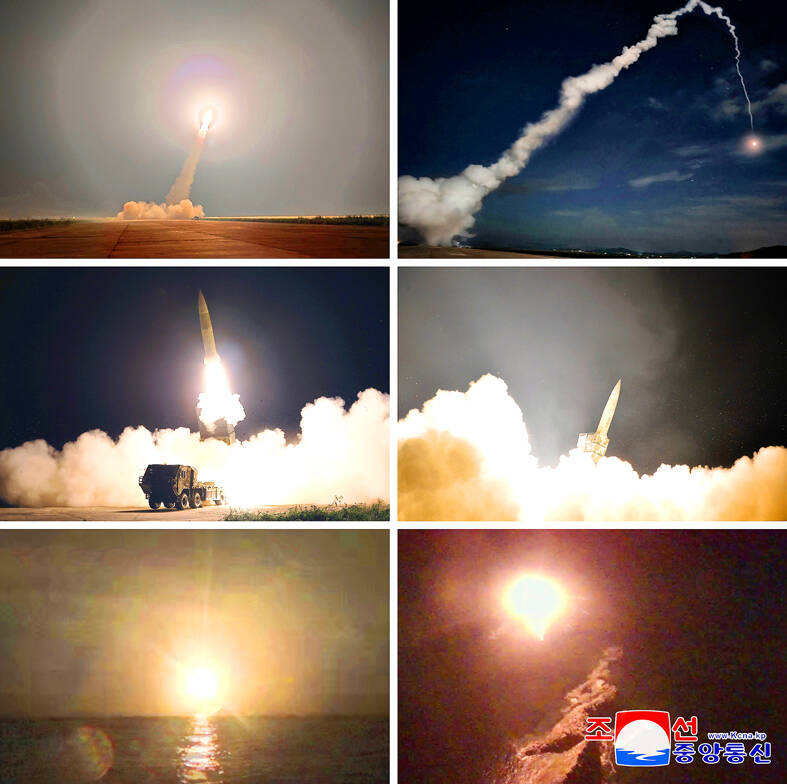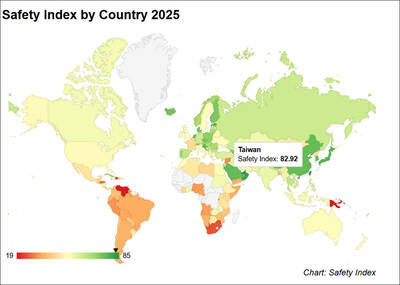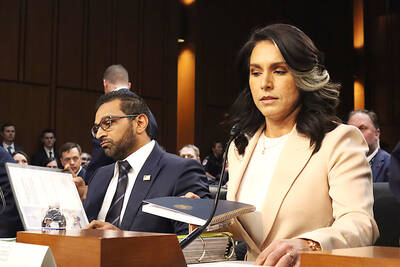North Korea yesterday said that its latest missile launches simulated “scorched earth” nuclear strikes on South Korea and that it has also been rehearsing an occupation of its rival’s territory in the event of conflict.
Pyongyang has previously tested nuclear-capable missiles and described how it would use them in potential wars with South Korea and the US. However, the North’s disclosure of detailed war plans reaffirmed its aggressive nuclear doctrine to intimidate its opponents, as it escalates its protest of the ongoing South Korean-US military exercises that it views as a major security threat, observers said.
North Korea’s military fired two tactical ballistic missiles from the capital on Wednesday night to practice “scorched earth strikes” at major command centers and operational airfields in South Korea, the official Korean Central News Agency (KCNA) said.

Photo: EPA-EFE
The North’s military said the missiles carried out their simulated strikes through air bursts, suggesting it confirmed the explosions of dummy warheads at a set altitude.
Pyongyang said its missile tests were in response to the US’ flyover of long-range B-1B bombers for a joint aerial training with South Korea earlier on Wednesday.
The aerial drill “is a serious threat to [North Korea] as it was just pursuant to the scenario for a pre-emptive nuclear strike at” North Korea, the Korean People’s Army (KPA) general staff said. “The KPA will never overlook the rash acts of the US forces and the [South Korean] military gangsters.”

Photo: EPA-EFE
The missile launches on Wednesday were the latest in the North’s barrage of weapons tests since last year.
The two short-range missiles traveled 360 to 400km at a maximum altitude of 50km before landing in the waters between the Korean Peninsula and Japan, South Korean and Japanese assessments showed.
South Korea’s Joint Chiefs of Staff called the launches “a grave provocation” that threatens international peace and violates UN Security Council resolutions that ban any ballistic launches by North Korea.
The US Indo-Pacific Command said that Washington’s commitment to the defense of South Korea and Japan remains “ironclad.”
KCNA said in a separate report that North Korean leader Kim Jong-un on Tuesday visited an army post where his military has been holding command post drills in response to the South Korean-US military training.
It said the drills are aimed at practicing procedures for “occupying the whole territory of the southern half” of the Korean Peninsula in the event of war.
Kim underscored the need to “deal a heavy blow at the enemy’s war potential and war command center and blinding their means of command communication at the initial stage of operation.”
Kim also detailed tasks to acquire an ability to launch “simultaneous super-intense strikes” at key enemy military targets and other sites whose destruction can cause social and economic chaos, KCNA said.

AIR SUPPORT: The Ministry of National Defense thanked the US for the delivery, adding that it was an indicator of the White House’s commitment to the Taiwan Relations Act Deputy Minister of National Defense Po Horng-huei (柏鴻輝) and Representative to the US Alexander Yui on Friday attended a delivery ceremony for the first of Taiwan’s long-awaited 66 F-16C/D Block 70 jets at a Lockheed Martin Corp factory in Greenville, South Carolina. “We are so proud to be the global home of the F-16 and to support Taiwan’s air defense capabilities,” US Representative William Timmons wrote on X, alongside a photograph of Taiwanese and US officials at the event. The F-16C/D Block 70 jets Taiwan ordered have the same capabilities as aircraft that had been upgraded to F-16Vs. The batch of Lockheed Martin

GRIDLOCK: The National Fire Agency’s Special Search and Rescue team is on standby to travel to the countries to help out with the rescue effort A powerful earthquake rocked Myanmar and neighboring Thailand yesterday, killing at least three people in Bangkok and burying dozens when a high-rise building under construction collapsed. Footage shared on social media from Myanmar’s second-largest city showed widespread destruction, raising fears that many were trapped under the rubble or killed. The magnitude 7.7 earthquake, with an epicenter near Mandalay in Myanmar, struck at midday and was followed by a strong magnitude 6.4 aftershock. The extent of death, injury and destruction — especially in Myanmar, which is embroiled in a civil war and where information is tightly controlled at the best of times —

Taiwan was ranked the fourth-safest country in the world with a score of 82.9, trailing only Andorra, the United Arab Emirates and Qatar in Numbeo’s Safety Index by Country report. Taiwan’s score improved by 0.1 points compared with last year’s mid-year report, which had Taiwan fourth with a score of 82.8. However, both scores were lower than in last year’s first review, when Taiwan scored 83.3, and are a long way from when Taiwan was named the second-safest country in the world in 2021, scoring 84.8. Taiwan ranked higher than Singapore in ninth with a score of 77.4 and Japan in 10th with

SECURITY RISK: If there is a conflict between China and Taiwan, ‘there would likely be significant consequences to global economic and security interests,’ it said China remains the top military and cyber threat to the US and continues to make progress on capabilities to seize Taiwan, a report by US intelligence agencies said on Tuesday. The report provides an overview of the “collective insights” of top US intelligence agencies about the security threats to the US posed by foreign nations and criminal organizations. In its Annual Threat Assessment, the agencies divided threats facing the US into two broad categories, “nonstate transnational criminals and terrorists” and “major state actors,” with China, Russia, Iran and North Korea named. Of those countries, “China presents the most comprehensive and robust military threat